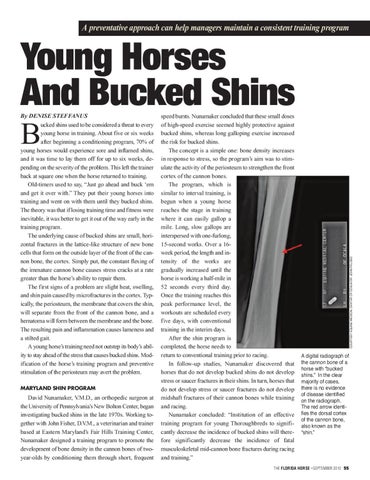BuckedShins.qxd:Florida Horse_template
9/1/10
11:41 AM
Page 55
A preventative approach can help managers maintain a consistent training program
By DENISE STEFFANUS ucked shins used to be considered a threat to every young horse in training. About five or six weeks after beginning a conditioning program, 70% of young horses would experience sore and inflamed shins, and it was time to lay them off for up to six weeks, depending on the severity of the problem. This left the trainer back at square one when the horse returned to training. Old-timers used to say, “Just go ahead and buck ‘em and get it over with.” They put their young horses into training and went on with them until they bucked shins. The theory was that if losing training time and fitness were inevitable, it was better to get it out of the way early in the training program. The underlying cause of bucked shins are small, horizontal fractures in the lattice-like structure of new bone cells that form on the outside layer of the front of the cannon bone, the cortex. Simply put, the constant flexing of the immature cannon bone causes stress cracks at a rate greater than the horse’s ability to repair them. The first signs of a problem are slight heat, swelling, and shin pain caused by microfractures in the cortex. Typically, the periosteum, the membrane that covers the shin, will separate from the front of the cannon bone, and a hematoma will form between the membrane and the bone. The resulting pain and inflammation causes lameness and a stilted gait. A young horse’s training need not outstep its body’s ability to stay ahead of the stress that causes bucked shins. Modification of the horse’s training program and preventive stimulation of the periosteum may avert the problem.
B
MARYLAND SHIN PROGRAM
David Nunamaker, V.M.D., an orthopedic surgeon at the University of Pennsylvania’s New Bolton Center, began investigating bucked shins in the late 1970s. Working together with John Fisher, D.V.M., a veterinarian and trainer based at Eastern Maryland’s Fair Hills Training Center, Nunamaker designed a training program to promote the development of bone density in the cannon bones of twoyear-olds by conditioning them through short, frequent
speed bursts. Nunamaker concluded that these small doses of high-speed exercise seemed highly protective against bucked shins, whereas long galloping exercise increased the risk for bucked shins. The concept is a simple one: bone density increases in response to stress, so the program’s aim was to stimulate the activity of the periosteum to strengthen the front cortex of the cannon bones. The program, which is similar to interval training, is begun when a young horse reaches the stage in training where it can easily gallop a mile. Long, slow gallops are interspersed with one-furlong, 15-second works. Over a 16week period, the length and intensity of the works are gradually increased until the horse is working a half-mile in 52 seconds every third day. Once the training reaches this peak performance level, the workouts are scheduled every five days, with conventional training in the interim days. After the shin program is completed, the horse needs to return to conventional training prior to racing. In follow-up studies, Nunamaker discovered that horses that do not develop bucked shins do not develop stress or saucer fractures in their shins. In turn, horses that do not develop stress or saucer fractures do not develop midshaft fractures of their cannon bones while training and racing. Nunamaker concluded: “Institution of an effective training program for young Thoroughbreds to significantly decrease the incidence of bucked shins will therefore significantly decrease the incidence of fatal musculoskeletal mid-cannon bone fractures during racing and training.”
COURTESY EQUINE MEDICAL CENTER OF OCALA/DR. JOHN PELOSO
Young Horses And Bucked Shins
A digital radiograph of the cannon bone of a horse with “bucked shins.” In the clear majority of cases, there is no evidence of disease identified on the radiograph. The red arrow identifies the dorsal cortex of the cannon bone, also known as the “shin.”
THE FLORIDA HORSE • SEPTEMBER 2010 55
